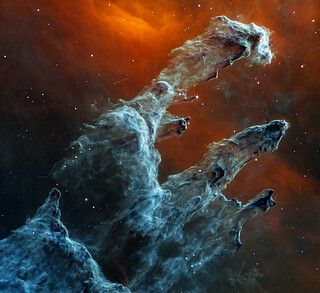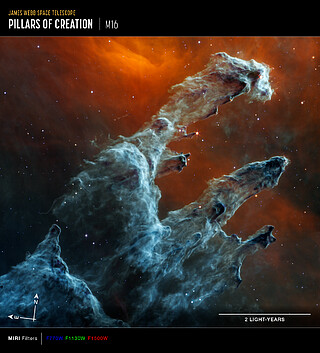weic2218 — Photo Release
Haunting Portrait: Webb Reveals Dust and Structure in Pillars of Creation
28 October 2022
This is not an ethereal landscape of time-forgotten tombs. Nor are these soot-tinged fingers reaching out. These pillars, flush with gas and dust, ‘enshroud’ stars that are slowly forming over many millennia. The NASA/ESA/CSA James Webb Space Telescope has snapped this eerie, extremely dusty view of the Pillars of Creation in mid-infrared light — showing us a new view of a familiar landscape.
Why does mid-infrared light evoke such a sombre, chilling mood in Webb’s Mid-Infrared Instrument (MIRI) image? Interstellar dust cloaks the scene. And while mid-infrared light specialises in detailing where dust is, the stars aren’t bright enough at these wavelengths to appear. Instead, these looming, leaden-hued pillars of gas and dust gleam at their edges, hinting at the activity within.
Thousands and thousands of stars have formed in this region. This is made plain when examining Webb’s recent Near-Infrared Camera (NIRCam) image of this object. In MIRI’s view, the majority of the stars are missing. Why? Many newly formed stars are no longer surrounded by enough dust to be detected in mid-infrared light. So MIRI is only able to see those young stars that have not yet cast off their dusty ‘cloaks’. These are the crimson orbs toward the fringes of the pillars. In contrast, the blue stars that dot the scene are ageing, which means they have shed most of their layers of gas and dust.
Mid-infrared light excels at revealing gas and dust in extreme detail. This is also unmistakable throughout the background. The densest areas of dust are the darkest shades of grey. The red region toward the top, which forms an uncanny V, like an owl with outstretched wings, is where the dust is diffuse and cooler. Notice that no background galaxies make an appearance — the interstellar medium in the densest part of the Milky Way’s disc is too swollen with gas and dust to allow their distant light to penetrate.
How vast is this landscape? Trace the topmost pillar, landing on the bright red star jutting out of its lower edge like a broomstick. This star and its dusty shroud are larger than the size of our entire Solar System.
This scene was first imaged by the NASA/ESA Hubble Space Telescope in 1995, and again in 2014, but many other world-class observatories have also stared deeply at this region, such as ESA's Herschel Telescope. Each advanced instrument offers researchers tantalising new details about this region, which is practically overflowing with stars. With every observation, astronomers gain new information, and through their ongoing research build a deeper understanding of this star-forming region. Each newly imaged wavelength of light and each new instrument delivers ever more precise information about the gas, dust and stars, which informs researchers’ models of how stars form. As a result of the new MIRI image, astronomers now have data in mid-infrared light at higher resolution than ever before, and will analyse its far more precise dust measurements to create a more complete three-dimensional landscape of this distant region.
The Pillars of Creation lie within the vast Eagle Nebula, which is 6500 light-years away.
More information
Webb is the largest, most powerful telescope ever launched into space. Under an international collaboration agreement, ESA provided the telescope’s launch service, using the Ariane 5 launch vehicle. Working with partners, ESA was responsible for the development and qualification of Ariane 5 adaptations for the Webb mission and for the procurement of the launch service by Arianespace. ESA also provided the workhorse spectrograph NIRSpec and 50% of the mid-infrared instrument MIRI, which was designed and built by a consortium of nationally funded European Institutes (The MIRI European Consortium) in partnership with JPL and the University of Arizona.
Webb is an international partnership between NASA, ESA and the Canadian Space Agency (CSA).
Image Credit: NASA, ESA, CSA, STScI, J. DePasquale (STScI), A. Pagan (STScI)
Links
- Webb’s NIRCam Image of the Pillars of Creation
- Webb’s MIRI Instrument
- Collection of Webb’s First Images
- Explore All of Webb’s Images
- ESA Webb Seeing Farther Interactive Brochure
- Release on ESA website
- Release on STScI website
Contacts
Bethany Downer
ESA/Webb Chief Science Communications Officer
Email: [email protected]
Ninja Menning
ESA Newsroom and Media Relations Office
Email: [email protected]
About the Release
| Release No.: | weic2218 | |
|---|---|---|








